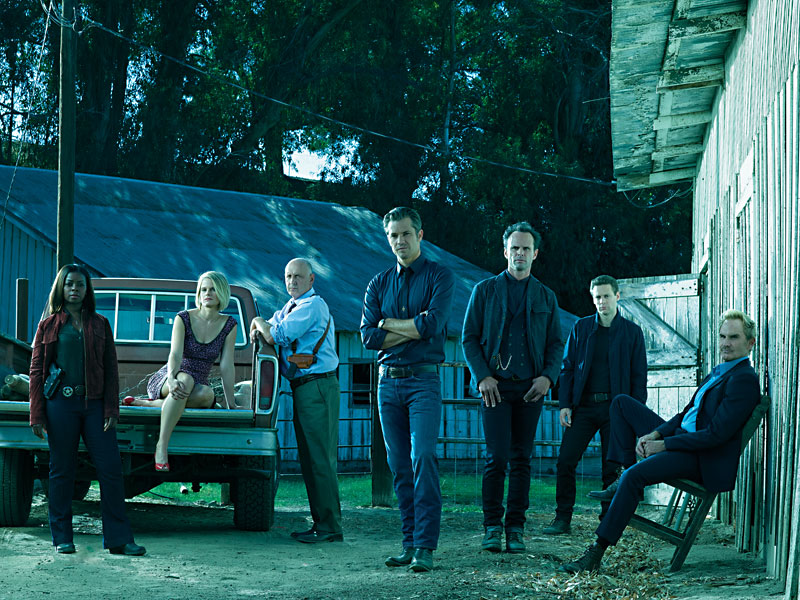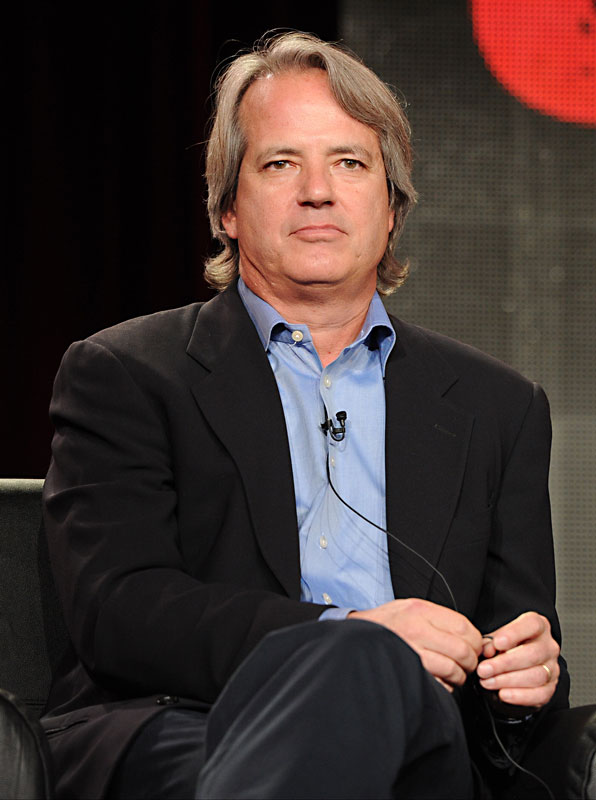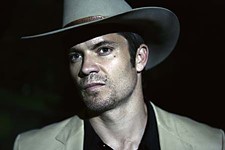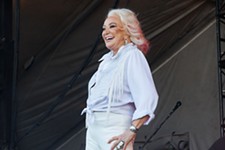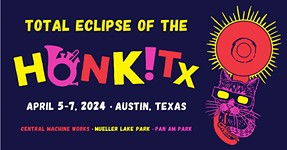You Are Entering Harlan County
Justified creator Graham Yost exits Kentucky for the ATX Television Festival
By Raoul Hernandez, Fri., June 5, 2015
"They had dug coal together as young men and then lost touch over the years," wrote the late, great Elmore Leonard as an opening. "Now it looked like they'd be meeting again, this time as lawman and felon, Raylan Givens and Boyd Crowder."
Nine years after its publication, Justified premiered on the F/X network in 2010 with Timothy Olyphant as a Federal Marshall and Walton Goggins as his nemesis. In April, after six seasons, Justified ended the same way it began: facing off Givens/Olyphant and Crowder/Goggins. Graham Yost, who developed the series for TV, appears eager to return to the ATX Television Festival and discuss it.
"My wife and I went to the festival last year," he affirms by phone from his office in Los Angeles. "[We] fell in love with Austin immediately. We were down on South Congress at Hotel San Jose, which was way more hip than we are. We just love Austin. My sister's brother, my brother-in-law, moved to Georgetown last year, so there's a big draw for us to go to Austin."
Austin Chronicle: Let me begin by saying I haven't seen the last season, and –
Graham Yost: Everybody dies!
AC: [Laughs]
GY: Everybody dies.
AC: Preparing for this interview, I located my Elmore Leonard paperback that has the short story "Fire in the Hole," upon which Justified is based, and read it finally. I'd devoured both Raylan Givens novels years ago, Riding the Rap and Pronto. So was it the case then that you read the story and the series followed?
GY: No, and yes. [Justified] says "based on 'Fire in the Hole,'" because that's a contractual thing. That's the story Sony bought, so that's what it had to say. But, in truth, the story was just the jumping-off point. The story really is what we used for the pilot. That first hour is the entirety of "Fire in the Hole," with the big difference being that Elmore had Boyd die and we kept Boyd alive.
There are other changes, too. In the story, Raylan and Winona have children; we decided we didn't want children at this point. Raylan's father had been a miner, a coal miner who died of black lung. We thought it'd be better to keep the father around and have him be a career criminal. There were additional characters created, but that's what the story gave. The story also gave us a lot of wonderful scenes that I completely just retyped into screenplay form.
AC: Hard to divorce yourself from screen treatments of something when you're reading the origin material, but it's remarkable how the voices of Raylan, Boyd, and Ava in Leonard's story come alive almost exactly in the series.
GY: Yes. That's the yes part when you ask if the series is based on this story. Yes, because Raylan, Boyd, and Ava, and Art are very well articulated by Elmore in that story.
AC: And even Dewey Crowe!
GY: And Dewey. And Dewey. And those characters formed a huge part of the series, so we tried to stay true to how they were introduced.
AC: What was your point of entry for the series? Had you read the novels? When did you begin thinking, "This character can carry a series."
GY: Honestly, it's in the first scene with Dewey Crowe. Raylan has gone to Ava's house looking for information that might lead him to Boyd. Ava goes up to shower, and Raylan's alone downstairs when Dewey just walks in. Raylan sends him out, first looking at him and his Nazi tattoos, and the gator-tooth necklace. Dewey says, "I'll go out and come back in," he gets a shotgun, and Raylan comes out. So when I got to that point, Raylan just telling Dewey what is going to happen if Dewey decided to try and rack a load – that Raylan is going to put a hole in him – that said to me, "We've got a shot at putting on television perhaps the coolest character in this era." That's what grabbed me. Elmore loved his characters to be cool, and Raylan's just about as cool as they come. I thought, "That could be a great lead for a series."
AC: Were you already an Elmore Leonard fan? Had you read the novels?
GY: I've been reading Elmore Leonard since the early to mid-Eighties. I started with LaBrava, and that hooked me. So I read another 10 to 15. Then in 2008, I had a deal at Sony. We were looking for something to do together. They had optioned the story for producers Sarah Timberman and Carl Beverly. They had already attached the director, Michael Dinner. So, I was actually the fourth person to arrive at the party. But I read it in one night, and the next day said yes, because I love Elmore Leonard, and I love the fact that the story's not in the usual Elmore Leonard territory of either Florida or Detroit. I loved the fact that it's in Kentucky. I thought that made it singular. That's when I came on board, in 2008, and that was late summer. We pitched it that fall, and FX was the right home for it, we felt. John Landgraf, in particular, was the right head of a network to buy this, because he had worked on a show with Michael Dinner and Sarah Timberman called Karen Sisco, which was an adaption of the Sisco character that Elmore had created. She's the Jennifer Lopez character in Out of Sight. So they were familiar with Elmore. They loved Elmore and were excited at the idea of trying to do that on a weekly basis.
AC: Did you then at some point go back and read the Raylan Givens novels?
GY: I'd read Riding the Rap, and had Pronto. When I bought it, I read a little bit and then stopped, because I knew it was going to Italy and I wanted to be in normal Elmore territory. But, as soon as this came along, then I read it and went, "Oh. It's only in Italy for a third, and the Italy stuff's fantastic," and it gave a greater sense of Raylan. So, I was certainly familiar with Raylan before I read "Fire in the Hole."
AC: So you read the story, say yes the next day, and the dominoes begin to fall. When in that process did you then meet Elmore Leonard, and what was that like?
GY: Didn't meet Elmore until after the pilot was shot. I talked to him on the phone once, I believe, after he read my draft – my script.
AC: Did he give you notes on your script?
GY: No, Elmore never did that. He'd been a screenwriter back in the Sixties and Seventies, and the reason he stopped doing that, as lucrative as it was, was that he did not like to get notes. So he was never about to give us notes. He would sell his material and hope for the best. He was both poorly served and well served. He was hoping that we'd fall into that second category, and it was always our goal to do so. I was a big fan of Out of Sight and Get Shorty, and both of those were adapted by Scott Frank. I felt what he had done in those screenplays was use as much Elmore as he could. I think the mistakes other people have made in the past is buying his material, his books, to get the stories, and maybe little bits of the characters. But man, he wrote great dialogue, so you might as well use that.
AC: Were you nervous getting on the phone with Elmore Leonard?
GY: Oh, yeah. I was nervous. And once he said he liked it, I joked with him, "Of course you do. Half the script is from your story." Beat by beat, line by line. Then he saw the pilot and really quite liked it. He had some concerns about Raylan's hat. He envisioned more what is known as a businessman's Stetson, which is a little smaller of a brim, and the crown isn't so high. And that hat had been tried on Tim, it just didn't work as good as more of a regular cowboy hat. He came to terms with it. He did say as the years went by that he felt that Tim was the best screen incarnation of any of his characters. That was pretty great.
I'm trying to remember exactly the first time I met him. I know that he came out that fall, when we were shooting the first season. He spent a day on the set, and he spent a day in the writers' room and up in the editing suites looking at scenes. That may have been the first time, but I have a feeling I met him before that. And then I would see him probably once or twice a year for the next four years.
AC: Was that like the godfather visiting the set? Everyone's whispering and trying not to look? Or was he available to whoever wanted to talk to him?
GY: Oh totally. It's not the godfather, but as Walton [Goggins] put it, "That's him. That's the man. That's the guy." But it took 30 seconds of meeting him to realize that he really is like his characters. He's just a cool, relaxed guy. He's very funny. He was very easy to talk to – and with. That was one of the great joys of doing the series, was getting to know him, and spending time with him over the years.
AC: Raylan Givens is such a great character. I felt like he was strong enough to carry the series like Gunsmoke – for decades. Now that it's over, was it too long, too short, just right?
GY: You know, we'd rather leave people wanting more than them saying, "Oh. Is that still on the air?"
AC: It seems that with all the great cable series from The Sopranos on down is that the moment it becomes a success there's this pressure on the producers to then wrap it up in good order.
GY: Well, I think that pressure exists if you're lucky enough to go as long as you wanna go. So as soon as you reach that point where you're going to be renewed year after year, then the pressure built into that is how are you going to end it. It's a simple fact of this business that, especially with the main talent, you make deals going into it for how long they're going to do the show. If you want to go past that, and the show is in any way a hit – or successful enough that it's being asked back year after year – the costs just become prohibitive. Sony and F/X were interested in doing a seventh season, but what they really wanted was for us to shoot a very long fifth season, carve that into two shorter seasons, and then do a final seventh.
We felt that could kill us. It was hard enough to just do 13 episodes in a year. To try and do 20 or 22 one year and then go right into a final season wouldn't result in the best work. More important than that, we didn't feel we had enough story, enough turns to go another season. It just felt like the story of Raylan and Boyd, and Ava, which is really what this series came down to, could last six years and no more.
AC: At what point did you come to that realization? Second season, fourth season?
GY: It was toward the end of the fourth season, when I started to talk to Sony and F/X about it. Then Tim and I started to talk about it, and then Sarah and Carl and Michael, and Fred Golan, who were all the executive producers at that point. We hashed it out for a while. A lot of people liked the idea of doing more, but Tim and I looked at each other – "I think six is right." That's the right amount.
AC: You were the fourth person to the series after producers Sarah Timberman and Carl Beverly, and director Michael Dinner. At what point does the name Timothy Olyphant come up?
GY: Timothy Olyphant was brought up right as soon as F/X said, "Let's shoot the pilot." That was after I turned in the script and made some revisions and they said, "Okay, let's do this." But he was not available. He was doing a movie. We thought about other people, and it was clear that there was no one who was as right for it as Tim was. So we decided to wait, and F/X was able to do that, because being a cable outfit, they can say, "We'll launch the show in March. We'll shoot the pilot in June, decide if we want to do it then, assemble a writers' room in August if that's how it goes, start shooting in October, and we'll be ready to go on the air by March." So that's what we did.
AC: Had you been a fan of Deadwood? Perfect segue from Olyphant's marshal on HBO to the marshal in Justified.
GY: I was not a watcher of Deadwood. I'd seen some of it. With the age of my kids and what we were watching at the time, it just didn't latch on for us as a family. I'd seen enough of Deadwood, but I'd also seen Tim in other things. In Deadwood, Seth Bullock is a very taciturn, rather grim, serious, dark character. But you see Tim in Go, you see him in Catch and Release with Jennifer Garner, you see him in [A] Perfect Getaway with Steve Zahn, and even as the bad guy in [Live Free or] Die Hard, that there's something about him, that you realized he could do all these things. He could be cool, he could be charming, he could be sexy, he could be romantic. He could also be very serious, scary, threatening, violent. And that's the great thing about Raylan, is that he's all those things. Tim was perfect for that.
The big thing is, in Elmore's world, the characters are funny and yet no one laughs, because they're not making jokes. That's just the way they see the world, and the way they verbalize it. Raylan needed that sense of humor, so the fact that Tim had done comedy and done it very successfully was a key ingredient in him being Raylan.
AC: We're living in an antihero age, and yet Raylan is a white hat – the good guy. Is that too reductive?
GY: Frankly, that was a concern for us going on F/X, because they had made their bones in the worlds of antiheroes, whether it's [The Shield's] Vic Mackey or Denis Leary's character on Rescue Me, and the guys in Nip/Tuck. So we were concerned about going on a cable outfit that was used to antiheroes. When push came to shove and we shot this thing, would they put it on the air? Because it didn't fit in with their brand at that point. On the other hand, we could see that was the time for F/X to try something different. So it felt, actually, like, "Oh, this will be a good fit."
And it's not reductive. Raylan is a hero. Raylan is a hero who does some bad things – or questionable things. He'll always defend them, although it doesn't take much poking to have him recognize that he has crossed a line or come very close to a serious problem here and there, but he's a hero. That's what I want to watch week in, week out. I enjoy that. That said, I've also worked on The Americans, and Philip and Elizabeth Jennings – they're the bad guys. And yet, they're the heroes of the show. They're trying to be good guys. They're not malevolent. They're not scheming because they want to do awful things. They feel they're serving a cause. It's just a cause that was the wrong side of history.
But anyway, I like heroes.
AC: Did you experience the parallel that I often did with Raylan – Clint Eastwood? The squint, the lean good looks, and that you were never, ever gonna draw down on dead-eye Dick.
GY: Yes. It's funny, because in the (I think it's) Dreamworks film Rango, there's an animated Clint Eastwood character, and Tim's doing his voice. He's not doing Eastwood, but he's doing in his neighborhood. Tim loves Clint Eastwood – loves the movies he's done. I think one similarity to Eastwood was Unforgiven. That's such a deconstruction of the Western. We were trying to deconstruct that archetype as well, to a degree, in showing the shadings of his character and the fact that he's somewhat a man out of time. He wasn't born in the right century for the kind of job he'd like to do.
AC: But had you seen the Eastwood thing early on?
GY: I'm a huge fan of Eastwood. I think, though, that it's a long tradition, and it's not just Eastwood. Really, it's Gary Cooper. It's Gregory Peck, to an extent, in The Big Country. It's even Alan Ladd in Shane. That the guy has a code. He's a good guy. He will do what's right even if it's costs him, and I think that's the definition of a hero. It's John Wayne in The Searchers. These guys don't lose their cool, and I think Raylan's part of that.
AC: Does that then make Justified a modern Western?
GY: Elmore didn't. Elmore didn't think that at all, and Elmore wrote Westerns, so he should know. On the other hand, what I read of Elmore's Western fiction was always, at its heart, crime fiction. Some bad guy is doing some bad thing for money. And I think a lot of his crime fiction had elements of the Western in it. When Michael Dinner was planning how to shoot the pilot, he wanted to shoot it in a classic Western style: low angles, big vistas, and hero shots in a very clean, classic way. That became part of our stylistic approach throughout the whole series.
So, yes. We did think of it to a degree as a modern Western, but not slavishly so. There were things we looked to quote and go at that were sort of Western tropes.
AC: The series Longmire is more overtly Western, but it nevertheless feels like they took a page from Justified.
GY: I think it might be more along the lines that the reasonable success of Justified then gave other people license, or the freedom – the green light – to go their way with a modern Western. It made the water safe. Just knowing how Hollywood works, I would assume that with Longmire, which is based on a series of novels, that people have been trying to get that on its feet for a long time. The fact that Justified made it on the air and was asked back probably said to people, "Okay, yeah. Maybe we can do this now."
AC: Timothy Olyphant as Raylan Givens aside, the real revelation of the series was Walton Goggins as Boyd Crowder. Where did y'all find him?
GY: He was on The Shield for seven years. He played Shane, and was a big part of the early success of FX. So he's a favorite son at FX, and it was their idea to cast him as Boyd. After we did the pilot, we all had that thought of, "Man, it's a shame we killed him off, because he was great." And he's great with Tim. Walton and Tim just had instant chemistry. The characters are wonderful reflections of each other. Testing said the same thing. People said. "It's a shame you killed this guy off." So we all talked about it and decided, "Yeah, let's keep him alive."
AC: Did he instantly inhabit that character, or were the writers writing for Walton because he has such verve?
GY: You know, it has to be both, because you can't write for him before you know him. He inhabited the character that Elmore created and that I then transcribed. Then we didn't have a lot of access to Walton that first season. The first half he was off doing a movie, so he worked with what we gave him. And we kept on going down the road that Elmore paved. When we got more of him, then [Justified] got more of him. Walton would have ideas and ways of turning a speech around, and that kind of thing. But then as we saw more and more of what he was doing, we got more excited and started to push things toward that. So it started with him inhabiting the character, then it progressed with us throwing stuff at him, because we had so much fun writing for him.
AC: ALL the actors are exemplary in the show – Joelle Carter as Ava Crowder, Nick Searcy as Art Mullen, Damon Herriman as Dewey Crowe. Is casting for a series done by committee or do we need to shout-out the show's casting director?
GY: I think Elmore created great characters, so we had something very specific to give these actors. Some parts people auditioned for, and some parts were just cast. Raylan was cast, Boyd was cast. Joelle was among a small group of actresses that auditioned for Ava, but it was clear from watching her audition that she was the one. Nick Searcy as Art Mullen, he was just cast. I'd worked with him years ago on From the Earth to the Moon. That first night I read the short story, I said, "Well, Nick could play Art." [Texan] Erica [Tazel] was cast from a group of actresses [as Raylan's partner Rachel Brooks]. Damon Herriman playing Dewey; he was just one of a group that came in, and it was clear that he was the guy. And on down the road.
But a key part of that is our casting director Cami[lle] Patton, who worked on Band on Brothers, though I didn't know her while we were doing that. Then we did a series together named Boomtown back in 2002 and we worked together a lot since. She just has a great feel for material. Once she saw what we were doing, she knew the people to go to. She would continually surprise throughout the six years. Not really surprise us, but just delight us with these great choices.
AC: As a veteran of television and film, where do past projects sit with you? Do the characters recede into you, or are they akin to someone you knew in high school? What happens when it's all over?
GY: This is the only time I've worked on a series that's gone the full run. I did two other series in television. Boomtown lasted a year and a half – a season and a half [2002-2003] – and Raines just lasted half a season [2007]. The other stuff I've done in television is miniseries, where the end date was baked into the recipe right from the very beginning. I would say that the Boomtown characters stayed with me, and continue to stay with me 12, 13 years on. I imagine the same will be true of the Justified characters.
AC: Will you take a trophy with you from the series, a cast photo or prop?
GY: There's a bunch of things. I have a sign that was used on the show – "You Are Entering Harlan County." I have a poster from the second season, a horizontal ad that might appear on the side of a bus, but it was shorter than that. It's mounted on wood, and I got all the cast members and writers to sign it. And just other little geegaws here and there.
AC: Sad it's over?
GY: Yeah, I'm sad. Walton said that when they finished The Shield that the real sadness didn't kick in until several months later, when he realized they weren't all getting back together again to do another season. So, come July, when I'm not gathering with the other writers, that'll be weird.
AC: You're coming to town for the ATX Television Festival. Been here before?
GY: Yes, my wife and I went to the festival last year. There was a reunion of the very first show I worked on, back in the beginning of time, at Nickelodeon 25 years ago, called Hey Dude. And also Joelle and I did a small panel thing for Justified. My wife and I fell in love with Austin immediately. We were down on South Congress, at Hotel San Jose. Which was way more hip than we are. We just love Austin. My wife's brother, my brother-in-law, moved to Georgetown last year, so there's a big draw for us to go to Austin.
AC: You're Canadian. Did you have a romance with the American West at some point?
GY: Definitely. I grew up watching Westerns. In general, America has always been something I was attracted to from an early age. You can get an attitude toward the U.S. sometimes in Canada, but that was never shared in my family. My father was very much a big booster of America, and American cinema in particular, so that was something that my brother and I both experienced as well. I'm interested in all the stories of all the regions of America, frankly. I'd love to do something set in Texas.
AC: South Congress definitely feels Old West.
GY: Yes, yes. And so much more. I had to go on a pilgrimage to the Lyndon Baines Johnson Library at the University of Texas. I've been reading the Robert Caro books about him over the years. So there's just a lot. And obviously the music is just tremendous. And then I like barbecue, so that's all good.





